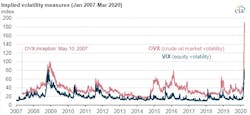Since the beginning of 2020 crude oil prices have fallen sharply, mainly due to economic contraction caused by the novel coronavirus (COVID-19) and the sudden increase in crude oil supply following suspension of the agreed reduction by the Organization of the Petroleum Exporting Countries (OPEC) and its partner countries. As demand declines and supplies increase, the daily price change of US benchmark crude West Texas Intermediate (WTI) has become extremely volatile, analysis from the US Energy Information Administration (EIA) shows.
Implied volatility measures an asset’s expected range of near-term price changes. OVX measures the implied volatility of oil prices and is calculated using movements in the prices of financial options for WTI. VIX measures the implied volatility of the Standard and Poor’s (S&P) 500. Crude oil volatility is typically higher than the S&P 500’s volatility, generally because OVX represents changes in one commodity and VIX represents changes across a diverse group of 500 companies.
According to the calculations by EIA, both volatility measures have been relatively high this month: on Mar. 16, the VIX index measured 82.7, a level higher than any point during the financial crisis of 2008-09, the last time the global economy experienced a significant recession. Crude oil market volatility has been even higher. On Mar. 20, OVX reached 190, the highest value since its inception in May 2007.
Since 1999, daily WTI crude oil futures prices have settled within 2% of the previous trading day’s price about 70% of the time. Nearly all (99.5%) of the daily WTI price changes since 1999 have settled within 10% of the previous day’s price; larger price changes are relatively rare. March 2020 has had 4 days where WTI prices decreased by more than 10% and 2 days where WTI prices increased by more than 10%.
The 25% decline on March 9 and the 24% decline on Mar. 18 were the two largest percentage declines in the WTI futures price since at least 1999. On the days following those declines, WTI prices rose by 10% (Mar. 10) and 24% (Mar. 19), likely in response to announced plans from various countries’ governments that emergency fiscal and monetary policy would be forthcoming.
Other highly volatile time periods, such as the 2008-09 financial crisis, also produced large price increases and decreases in quick succession. The largest single-day increase during the 2008-09 financial crisis—an 18% rise on Sept. 22, 2008—was followed by the largest single-day decrease, a 12% fall on Sept. 23.
